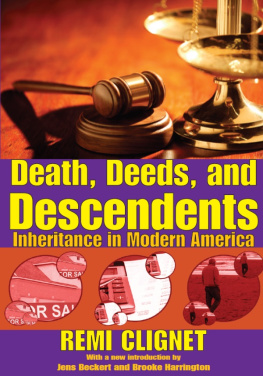First published 1992 by Transaction Publishers
Published 2017 by Routledge
2 Park Square, Milton Park, Abingdon, Oxon OX14 4RN 711 Third
Avenue, New York, NY 10017, USA
Routledge is an imprint of the Taylor & Francis Group, an informa business
Copyright 1992 by Taylor & Francis.
All rights reserved. No part of this book may be reprinted or reproduced or utilised in any form or by any electronic, mechanical, or other means, now known or hereafter invented, including photocopying and recording, or in any information storage or retrieval system, without permission in writing from the publishers.
Notice:
Product or corporate names may be trademarks or registered trademarks, and are used only for identification and explanation without intent to infringe.
Library of Congress Catalog Number: 2009013772
Library of Congress Cataloging-in-Publication Data
Clignet, Remi.
Death, deeds, and descendents : inheritance in modern America / Remi Clignet.
p.cm.
Includes bibliographical references and index.
ISBN 978-0-202-36256-4 (alk. paper)
1. Family-United States. 2. Inheritance and succession--Social aspects-- United States. 3. Wealth--Social aspects--United States. 4. Property--Social aspects--United States. I. Title.
HQ536.C55 2009
306.870973--dc22
2009013772
ISBN 13: 978-0-202-36256-4 (pbk)
Reproduction is the recurrent theme throughout Remy Clignets 40-year research career. He has examined processes of reproduction, as well as their consequences, within a remarkable variety of contexts, including education, the family, art, and wealth. Such research must inevitably address most of the major institutions and processes of social life (ranging from the market and the law to biology and heredity) and Cligneta sociology professor who also holds a law degreepossesses the rare combination of skills needed to address his subject in a comprehensive manner.
Through the study of inheritance, he found a worthy topic for his wide- ranging expertise. In Death, Deeds and Descendents, his core research interests of the previous 25 years came together, as he suggests on page 38: Heredity, inheritance, and heritage, as forms of transfer, respectively, of genetic, economic, and cultural capital, interact constantly with one another. Clignet thus treats inheritance as a complex phenomenon composed of multiple interacting processes, of which the material aspectthe intergenerational transfer of wealthis not necessarily the most significant, or most sociologically interesting, part.
While inheritance has long engaged the attention of economists (e.g., Lait- ner 1979, 2001) and anthropologists (Goody 1976; Hann 2008)), it remained a sociological lacuna (McNamee/Miller 1989) in post-war sociology. For the founding fathers of sociology, especially for Emile Durkheim (Durkheim 1992) and Max Weber (Weber 1978), inheritance was an important topic. But at around 1930 interest in the study of inheritance receded in sociology. Even within the sociology of wealth and finance (Keister 2000) inheritance has remained a black box in most studies of wealth accumulation and distribution (Keister/Moller 2000: 76). This is due partly to the difficulty of obtaining data on intergenerational transfers, and partly to social scientists ideological commitment to the study of income and occupation, as opposed to processes of ascriptive reproduction of wealth and privilege.
In the opening pages of Death, Deeds and Descendents, Clignet points to the pivotal role of functionalism for understanding the striking lack of socio logical attention to a topic whose significance seems obvious. Functionalist modernization theory started from the assumptions of self-reliance and achievement as the building blocks of contemporary society. Intergenerational solidarities and the transfer of wealth did not play a role in this account because they did not fit into the model of social organization. Talcott Parsons (Parsons 1954: 180) described the American kinship structure as made up exclusively of interlocking conjugal families, with claims of solidarity largely restricted to parents and their minor children. Further, he claimed that individual families were structurally segregated from one another (1954: 185), both as a precondition for increasing affect- orientation within marital relationships, and for the fulfillment of functional demands arising from occupational roles.
This presumed isolation of conjugal families does not do justice to the phenomenon of inheritance. As Clignet shows in his book, and as many sociologists have demonstrated subsequently (Attias-Donfut 1995; Kohli 1999), bequests or inter vivos transfers create material and affective bonds among adults in the descent line. Presumably, Parsons neglected this insight because of his assumptions about the development of modern society. For if we follow Parsons pattern variables, meritocracyrather than ascribed statusis the dominant principle behind the contemporary social distribution of resources. This model leaves no room for the effortless accrual of wealth through inheritance. Parsons theory, developed in the 1940s and 1950s focuses chiefly on the urban middle class (Parsons 1954: 186), which derived its livelihood from gainful employment. The model was not oriented to the much smaller upper class, for whichas Parsons acknowledgedlega- cies, and thus also family continuity and patrilineal structures, continued to play an important role. However, Parsons justification for omitting the role of inheritance in the reproduction of social structure was not empirically supported: as Clignet shows inheritances play an important material and symbolic role for the middle class, as well as for the very rich.
But until the 1980s, this gap in the literature generated little concern. That sociological scholarship on inheritance has gained in importance since the first publication of Death, Deeds and Descendents is due in part to the massive concentration of wealth that took place in the U.S. in the last two decades of the twentieth century. Even economists took note of these developments, leading to a renewal of research linking the magnitude of bequests to the reproduction if social inequalities (cf. Modigliani 1988; Kotlikoff 1988). Early in the twenty- first century, further research in this vein suggested that the frugal habits of the Depression- era generation in America could produce an unprecedented volume and magnitude of bequests in the near future (Avery/Rendall 2002; Havens/Schervish 2003). In Europe, the same holds true for the post-war cohort, the only generation in the twentieth century that could build up private wealth uninterrupted by major economic crises, inflation or the destruction of war. In the United States, an estimated $550 billion are transferred annually by bequests or inter vivos gifts; this amounts to 4 percent of GDP (Havens/Schervish 2003). As one of the very early sociological studies to address the topic at length and in-depth, Death, Deeds and Descendents has remained a vital scholarly resource long after its initial publication in 1992.
Clignet takes an ambitious, multi-method approach to his subject. For instance, choosing the United States as the empirical setting for his inquiry allows him to examine inheritance not just as a means of reproducing family systems, but as a








